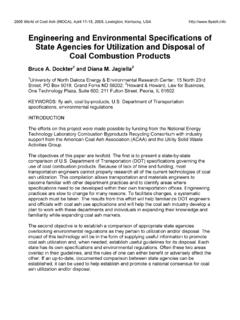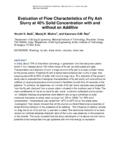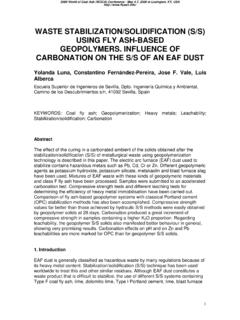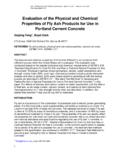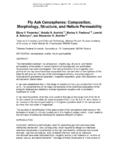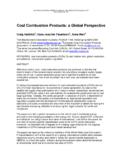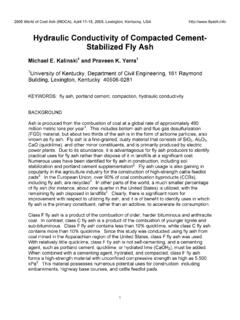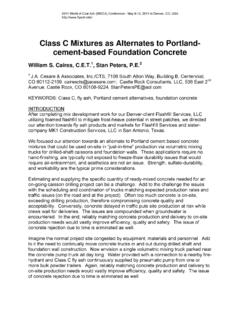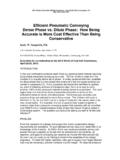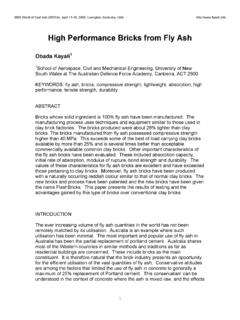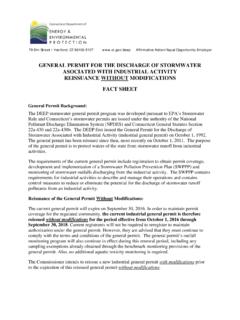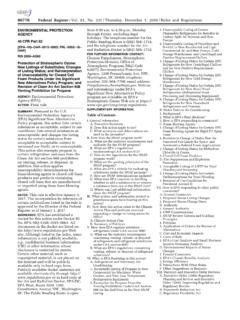Transcription of MAC® (Magaldi Ash Cooler) fully-dry bottom ash …
1 F. Bassetti et al 2015 World of Coal Ash Conference (WOCA) - (May 4-7 2015) Nashville, Tennessee, USA MAC - magaldi ASH COOLER fully -dry bottom ash removal system for elimination of ponds Fulvio Bassetti1, Daniele Coppola1, Daniele Ricci1 1 magaldi Power , Via Irno 219, 84135 Salerno (Italy) KEYWORDS: bottom ash, magaldi , dry extraction, boiler, efficiency, beneficiation, pond, impoundment, landfill ABSTRACT Coal combustion residuals (CCRs), commonly referred to as coal ash, are the materials that remain after burning coal for electricity. CCRs include bottom ash that generally accounts for 10 to 20% of the total ash production. Following the coal ash disasters in the of 2008 and 2014, CCRs management has become a critical point for both the environment protection and sustainability of power generation from coal.
2 In the bottom ash is commonly extracted using conventional wet systems, such as SCC systems (Submerged Scraper Conveyors) or WIH systems (Water Impounded Hoppers). This slurry of sludge is then hydraulically transported to a pond, that is a waste management facility consisting of an excavated, a dammed or diked reservoir in which coal bottom ash is disposed of. The coal bottom ash particles settle out and leave relatively clear water at the surface that is discharged through a designed and managed outlet structure to a nearby stream, surface water or plant process water system . This ash management demands high power, water and space for pond construction and maintenance. An alternative solution to conventional wet bottom ash handling systems is the MAC system magaldi Ash Cooler a fully -dry technology, using only ambient air instead of water for bottom ash cooling and handling.
3 The MAC system extracts bottom ash in a completely dry way from underneath the boiler and transports it to a temporary storage silo. The bottom ash can then be reused as a by-product in several applications or recycled back to the boiler and transformed into fly ash, eliminating the problematic and risky water systems completely. Moreover, the MAC system provides the benefit of energy recovered from dry bottom ash removal back to the boiler, thus increasing the boiler efficiency. As a result, the MAC fully -dry bottom ash removal technology supports operators and plant 2015 World of Coal Ash (WOCA) Conference in Nasvhille, TN - May 5-7, 2015 Bassetti et al 2015 World of Coal Ash Conference (WOCA) - (May 4-7 2015) Nashville, Tennessee, USA manufacturers in their efforts to make conventional coal power plants more flexible and more efficient.
4 Figure 1: MAC system - Typical Configuration. 1. INTRODUCTION: DISPOSAL OF COAL COMBUSTION RESIDUALS IN THE In the most prevalent type of electric utility coal-fired boiler, the so called dry- bottom boiler, about 80% of the total ash is fly ash and 20% is bottom ash. Coal ash is also referred to as coal combustion residuals or CCRs. In dry- bottom boilers the bottom ash falls through the furnace throat as solid particles. In most of the coal-fired power Boiler Storage Silo Postcooler MAC Extractor Crushing Stage bottom Hopper F. Bassetti et al 2015 World of Coal Ash Conference (WOCA) - (May 4-7 2015) Nashville, Tennessee, USA plants, the bottom ash falls into water-cooled bottom ash hoppers with sloping sides and crushers at the ash outlet.
5 The bottom ash is combined with water to create an ash slurry (water to approx. 20% solids by weight), which simplifies its transport. This slurry is usually pumped into surface impoundments, where the coal ash settles and the water is recycled back to the plant or discharged into a nearby waterway. Conveying bottom ash in a water slurry is called wet sluicing. EPA has identified 870 units (345 plants) that use wet sluice system . In most cases, the fly ash and the bottom ash are sluiced separately to final disposal impoundments. For several years, this process has been attractive. In 2012, the power sector used only 40% of total coal combustion residuals beneficially and 60% sluiced and disposed in more than one thousand active landfills and surface impoundments.
6 Therefore, the amount of CCRs stored in impoundments far exceeds its beneficial re-use demand. CCRs surface impoundments, also known as ash ponds, are similar to landfills in that both units are either a natural topographic depression, manmade excavation, or diked area. Surface impoundments can have natural clay liners or synthetic ones. Both help control leaching into groundwater. Ash ponds and landfills are, however, different in their use. Surface impoundments contain coal ash mixed with water and are generally used for temporary ash storage or treatment, whereas a landfill is an area designated for final CCRs disposal. Picture 1: Top view of a CCRs surface impoundment. Over the years, conventional ash disposal has been mostly ponds.
7 The land requirements have increased with ash production. At many locations in the , the availability of suitable disposal sites is becoming a problem that is complicated by the size of the site needed, its distance from the power plant, its soil conditions and topography, the sensitivity of the surroundings and the land cost. In recent years numerous ash ponds failures have led environmental groups, the general public and the courts to urge the Environmental Protection Agency (EPA) F. Bassetti et al 2015 World of Coal Ash Conference (WOCA) - (May 4-7 2015) Nashville, Tennessee, USA towards new regulations of CCRs. Six years after the massive coal ash spill at the Tennessee Valley Authority s (TVA) Kingston Power Plant, on December 19th 2014, the EPA released the long-delayed first federal regulations for disposal of CCRs from Electric Utilities and Independent Power Producers.
8 Final CCRs rule regulates coal ash as non-hazardous waste under Subtitle D of the Resource Conservation and Recovery Act and supports the responsible recycling of coal ash by distinguishing safe, beneficial use from disposal. Though CCRs is now regulated as non-hazardous waste, EPA has imposed nationally applicable minimum criteria for existing and new CCRs landfills and surface impoundments. Albeit the TVA incident was primary a structural containment failure after several vertical expansions, the main concerns driving the new CCRs rule are associated with contaminants leaching into groundwater or surface streams. New and existing CCRs landfills and surface impoundments, including any lateral expansion of these units, will be subject to location, design and operating restrictions, groundwater monitoring and other requirements.
9 For existing unlined CCRs ponds that are contaminating groundwater above a regulated constituent s groundwater protection standard to stop receiving CCRs and either retrofit or close, except in limited circumstances. Existing CCRs landfills and impoundments that cannot meet performance criteria also may need to be closed. CCRs surface impoundments that do not receive CCRs after the effective date of the rule, but still contain water and CCRs, will be subject to all applicable regulatory requirements, unless the owner or operator of the facility dewaters and installs a final cover system on these inactive units no later than three years from publication of the rule. All new landfills and ponds must include an impermeable liner to prevent CCRs contaminants from leaching into the ground (see next figure).
10 Figure 2: Schematic of typical CCRs landfill to conform to EPA s rule. F. Bassetti et al 2015 World of Coal Ash Conference (WOCA) - (May 4-7 2015) Nashville, Tennessee, USA The new EPA rule requires that CCRs stored near water bodies must be managed responsibly. The public expects greater responsibility from power industry and is unwilling to continue to accept CCRs spills into the nation s rivers. 2. OVERLAPPING BETWEEN CCRs AND ELG RULES In April 2013 the EPA proposed revision to the steam electric Effluent Limitation Guidelines (ELG) to account for technology improvements in the steam electric power industry over the last three decades and to address changes in wastewater composition resulting from the widespread installation of air pollution controls.
